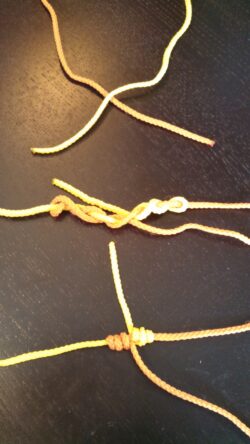Fly Fishing is the opposite of spin fishing. Spinning rods require that the weight of the bait or heavy lure pull line off the reel. In Fly Casting, the heavy line takes the fly along for the ride. Fly fishermen cast a line, not a fly.
Attached to the heavy line is a leader. The leader is the business end of the fishing rig. This means that the leader is made from clear monofilament. The butt section of a leader is the thickest and heaviest in strength. Each progressive section decreases in diameter and pound test.
To build a leader, you need to tie a proper knot. This means that you need to learn how to tie a Blood Knot. There are plenty of YouTube videos and directions on how to tie and master this difficult, but strong knot. Other line to line connection knots may be easier to tie, but do not have better knot strength.
No matter what knot you tie, some original knot poundage strength will be lost. That 4 lb. test will be less after it is knotted. A random spool of inexpensive monofilament varies in diameter and strength. The cheaper the line, the greater the differences. This is because the line is pulled onto a spool when being manufactured. Pulling the line can alter the consistency of the line.
Leader material is more expensive since it is extruded from the machine that manufactures it. Because of this, the diameter and strength integrity are more consistent. A 10 lb. test spool of quality tippet material is 10 lb. from start to finish. That is why they generally come on a 25-30-yard spool. You will need a different spool for each section of your tippet. Blood knots will connect sections of line diameters that are different, but only within a few pounds.
Some fly guys use basic spin fishing mono. This may be cheaper but spinning monofilament lacks any stiffness. Quality leader allows for a stiffer and gradual transition from the thick butt, attached to the fly line, to the finer and thinner tippet. Heavier mono will work fine for streamers and heavy nymphs. For more technical matching the hatch, you need a gradual transition from the butt to the terminal end of the leader.
Tying a Blood Knot is easier when practicing with thicker and heavier material. Try using 2 different colors of poly line. You can see and feel the line and how it needs to work. If your eyes are tired, use cheaters that will help you see the knot clearly. Lick the knot before you snatch it tight to prevent friction from weakening the tippet material even more.
The best quality tippet material is clear fluorocarbon. This premium line is thinner, but stronger than other monofilament materials. It is best used for the final section of your leader. Sun will degrade your material fast. Keep the tippet spools inside your vest, not around your neck or hanging from the outside.
You can use colored monofilament or a bungy material for a leader’s butt section. This allows the fisherman to better see any strikes from a streamer or nymph presentation. For dry fly fishing, this is not necessary.
The leader length and configuration will vary with species of fish, length of the fly rod, and casting styles. The shorter the leader, the easier it is to cast and set the hook. Longer leaders require longer rods to compensate.
There are many styles and stiffnesses of leader material. Find the ones that you have the most success with. Tie the leaders ahead of time and coil them into a plastic bag or sleeve. This will save time when you get tangled and must change the leader.
As a trout guy, I use leaders from 7 ½ feet to 10 feet in length. The shorter leaders work fine for most stream and river nymph and streamer fishing. Dry flies, terrestrials, and lake fishing means longer leaders. Salt and warm water fly fishermen often go heavier and longer.
The hardest part of dealing with leaders is tying the knots. You can purchase knotless leaders but at some point, you will need to tie some extra tippet onto the end. Wind knots, abrasions, break offs, and tying on flies will each reduce the length of your tippet material. Practice makes perfect.
If the tippet looks old, tired, rough, or has a wind knot, change it. It is guaranteed that if you do not address any of these problems, the next fish will be a monster that will break you off.
Follow the Leader!
Montana Grant
Join Montana Grant’s Facebook Group at Montana Fishing For Fun.